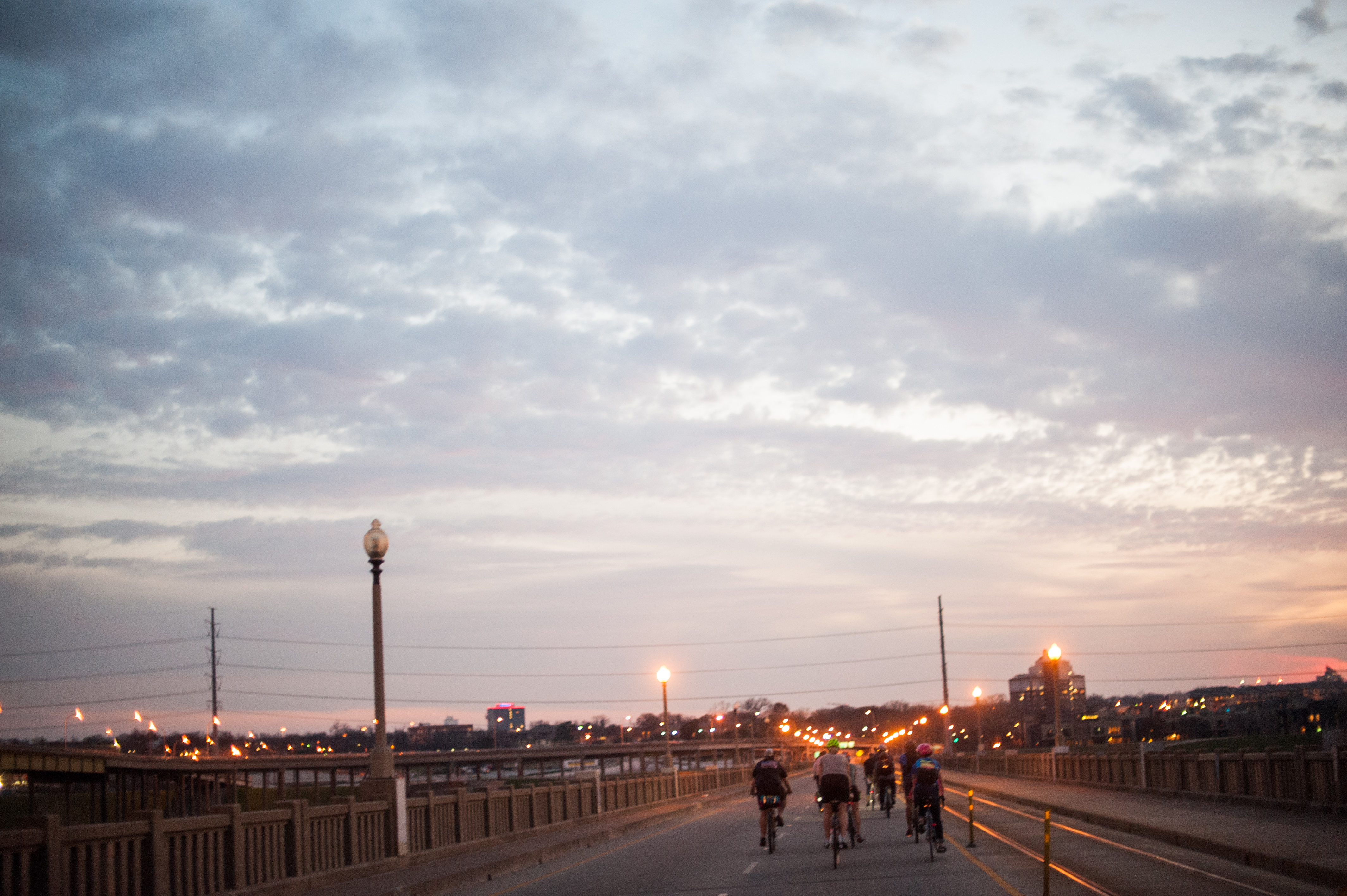On paper, Dallas looks like it is trying to be a bike friendly city. It claims to have some 74 miles of bike infrastructure. The City Council adopted a bike plan back in 2011 and employs staff to oversee its implementation. Since the creation of that plan, several new trails have opened, and a nonprofit is working to connect many of those trails into a large mega loop which will allow cyclists to navigate from the Katy Trail through East Dallas down into the Trinity Forest and back entirely on dedicated trails.
Yesterday, to highlight the importance of biking in Dallas, Mayor Pro Tem Chad West and council members Jesse Moreno and Paul Ridley led the 2021 Bike to City Hall event, an annual ride (though it missed last year due to COVID) to raise awareness around cycling. But as city council members attempt to shine a spotlight on biking in Dallas, a recent report by Vox reminds us that there is still an enormous gap between the way the city presents its bike facilities and what they are like to use.
The Vox report looks at how the Biden Administration’s infrastructure bill could impact urban cycling, and it uses Dallas as an example for how there is sometimes a disconnect between ways cities promote and fund bike facilities. It finds that Dallas has woefully underfunded bike infrastructure through the years, making Dallas one of the unfriendliest cities for cyclists in the United States.
For example, according to the city, Dallas boasts 74 miles of bike infrastructure“including painted guidance on streets” and “buffered bike lanes.” But just “5.3 miles of those are on-street protected bike lanes, “which include a physical barrier that shields riders from car traffic),” Vox reports. But Austin, by comparison, has more than 50 miles of on-street protected bike lanes. Houston has 22 miles.
As people who try to bike in Dallas know all too well, there is a big difference between cycling in a protected lane and cycling on a road where the city has painted a few bike stencils that allow it to claim additional miles of bike infrastructure. Vox spoke to a number of cyclists, some of them transplants from other cities who used to cycle regularly to work or to run errands. They tried to keep up the habit in Dallas, but soon abandoned the effort.
The gap is evident to many cyclists in Dallas, including Moffitt, who said there simply wasn’t a way for him to get from home to the office by bike without fearing for his safety.
“If you want to commute, you gotta be hyper-vigilant or have nothing to lose,” he told Vox. Another local biker echoed this sentiment in a Reddit post: “In a former life I would ride for coffee, beer and groceries, but here that feels like a death wish.”
There is a simple reason why Dallas’ cycling infrastructure is so inadequate. The city has never dedicated attention or money to it. The city was late to the game in investing in bicycling—there wasn’t a single dedicated or shared bike lane in the city until 2012, the year after the council adopted its bike plan. Federal, regional, and local funding for bicycling infrastructure has always been tough to find, but in Dallas the problem appears to be that many people have never viewed cycling as a legitimate means of urban transportation. This attitude is perhaps best summed up by the image posted to Twitter a few weeks ago showing a DART bus cruising down one of those new dedicated bike lanes, oblivious to its presence and purpose.
Other cities around the country, however, have found the political will to shift funding and planning to bike infrastructure, recognizing the myriad health, climate, recreational, and congestion benefits that can come by prioritizing cycling:
The benefits of better biking systems are evident: Cities like Portland, Oregon, and Boulder, Colorado, which have built out expansive biking networks, are poised to see big boosts for public health outcomes and economic development. Well-developed biking infrastructure could also prompt larger-scale lifestyle shifts that lead people to become less dependent on cars and more open to different modes of transportation, spurring reductions in congestion and pollution. And better biking networks mean that the activity is safer for those who already do it and more accessible to those who have yet to try.
The successes of these other cities is a reminder that inadequate funding has never really been the obstacle preventing Dallas from improving its streetscapes for cyclists. Rather, the problem has always been political will.
“City management never took it seriously and it was never funded properly,” former city council member Philip Kingston told Vox. Heather McNair, president of BikeDFW, described the city’s infrastructure as “woefully behind and inadequate,” pointing out that, as of 2021, only about 20 percent of the 2011 Bike Plan has been completed.
But that may be slowly starting to change. When I reached Mayor Pro Tem West yesterday after his ride, he said that this year’s ride comes at a time when the city is beginning to make more than symbolic gestures around cycling. For example, this year’s budget is the first that funds bike plan implementation at the level laid out in the 2011 plan. One of the reasons only 20 percent of that plan has been implemented, West explained, is that the city never bothered to dedicate the money it said it would.
That shift, West believes, did not happen because he and his collogues biked to City Hall. Over the last decade, bicycling has gone from a niche issue to something the city at large takes more seriously.
“I think you’ve always had a number of council members who were forward thinking on micro-mobility,” West said. “But I do think there has been a cultural shift.”
In addition to funding the existing bike plan, the city is also beginning the process of drafting an update to it. The council has also launched a new task force focused on “micro-mobility” that will look at improving the city’s streetscape for not only bikes, but also pedestrians, scooters, and other alternative forms of transit.
Significantly, it’s not just council that has enthusiasm for Dallas bicycling. West believes city staff finally gets it. And in Dallas’ council-manager former of government, staff buy-in is always crucial to pushing through the bureaucratic malaise.
“We do have a forward-thinking staff right now,” West said. “We used to have a bike czar, but we haven’t had anyone focusing on bikes for several years. Now we have Kathryn Rush; you can watch her on council videos, she’s sitting in her home office with bikes behind her hanging on the wall. She’s clearly a cyclist and passionate about cycling. It’s having that focus where you have a dedicated person on staff to push the envelope.”
The city is currently in the process of seeking consultants to help draft a new bike plan. There is, of course, plenty more to do in addition to reworking the bike plan. The city could revisit its street design planning process and make it so that any time a street is rebuilt it includes a bike lane. Dallas still has way too many streets that are unnecessarily wide, encouraging high speeds. By clawing back street space through road diets, the city could easily create safer buffers between cars, bikes, and pedestrians. After all, Dallas is dangerous for bicyclists not only because it doesn’t have many protected lanes; its auto-centric streets have been dangerously over-designed.
It is encouraging, though, that political climate around cycling appears to be shifting. Because if the Biden Administration manages to pass any legislation that boosts funding for cycling infrastructure, Dallas will only be able to capitalize on the opportunity by finding the political will to pursue and use it.
It must. No city should be a place where cyclists feel like getting on their bikes puts their lives at risk.




